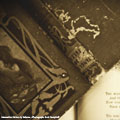Tea and Toast — 10 of 31
Maria del Pangolin
Section - Liquids and Vessels
[What was I thinking?]
A liquid is a kind of thing. A liquid is scenery.
Some cold water is a liquid in the Kitchen. The description of the cold water is "Cool, clear water." Understand "cool" or "clear" as cold water.
Some hot water is a liquid. The description of the hot water is "Hot water, ready to be poured over tea leaves to make tea."
Some hot tea is a liquid. The description of the hot tea is "Tea. No more need be said."
[Some cold tea is a liquid.]
Vessel-containment relates various things to one liquid (called the filling). The verb to be filled with implies the vessel-containment relation.
Before doing something when the current action involves the cold water and nothing is filled with the cold water and the sink is switched off:
say "(first switching on the sink)[command clarification break]";
try silently switching on the sink.
To fill (vessel - a thing) with (fluid - a liquid):
now the vessel is filled with the fluid;
now the fluid is in the kitchen.
To empty (fluid - a liquid) from (vessel - a thing):
now the vessel is not filled with the fluid;
unless something is filled with the fluid or the fluid is the cold water, remove the fluid from play.
After examining a liquid: if something is filled with the noun, say "Currently there is [noun] in [the list of things filled with the noun]."
A thing can be fillable or unfillable. A thing is usually unfillable. The kettle is fillable. The teapot is fillable. The tea strainer is fillable. A teacup is fillable. The rice cooker is fillable.
Filling is an action applying to one thing. Understand "fill [something]" as filling.
Filling it with is an action applying to two things. Understand "fill [something] with [something]" as filling it with. Understand "fill [something] up with [something]" as filling it with.
Understand "pour [something] in/into [something]" as inserting it into. [This is going to get redirected to filling anyway.]
Filling it from is an action applying to two things. Understand "fill [something] from [something]" as filling it from. Understand "fill [something] up from [something]" as filling it from.
Before inserting a liquid into something:
try filling the second noun with the noun instead.
First before inserting something into something when the noun is filled with something and the second noun is fillable:
add the noun to the things encountered, if absent;
try inserting the filling of the noun into the second noun instead. [This should catch "pour kettle into teapot"]
Check filling it with when the noun is unfillable: say "That's not something you can fill up." instead.
Check filling the tea strainer with something when the second noun is not the loose tea: say "The strainer is for holding tea." instead.
Check filling it with when the second noun is not a liquid and the noun is not the tea strainer: say "You can't fill [the noun] with [the second noun]." instead.
Check filling when the noun is unfillable: say "That's not something you can fill." instead.
Check filling it with when the noun is filled with something: say "[The noun] is already filled with [ filling of the noun]." instead.
Carry out filling it with when the noun is fillable:
if the second noun is a liquid:
fill the noun with the second noun;
otherwise:
now the noun is filled with the second noun.
Report filling it with: say "You fill [the noun] up with [second noun]."
Carry out filling the teapot with hot water when the kettle is filled with hot water: empty the hot water from the kettle.
Before filling something from the sink:
if the sink is switched off:
say "(first switching the sink on)[command clarification break]";
now the sink is switched on;
try filling the noun with cold water instead.
Before filling the tea strainer from the tea tin:
try filling the tea strainer instead.
Check filling it from when the second noun is unfillable: say "The [second noun] won't hold anything that you could fill something up with." instead.
Check filling it from when the second noun is fillable and the second noun is not filled with something: say "[The second noun] is empty." instead.
Carry out filling it from: try filling the noun with the filling of the second noun.
A thing has a thing called the preferred filling. [This assigns a preferred liquid to everything, but hopefully it won't matter.] The preferred filling of the kettle is cold water. The preferred filling of the teapot is hot water. The preferred filling of the strainer is loose tea. The preferred filling of a teacup is hot tea. The preferred filling of the rice cooker is cold water.
Instead of filling something: [this needs to be "instead" rather than "carry out" so an unsuccessful "fill teapot" doesn't run the after rules and discover a tchotchke]
if the preferred filling of the noun is not enclosed by the kitchen:
say "You don't have any [preferred filling of the noun] to fill [the noun] with.";
otherwise:
try filling the noun with the preferred filling of the noun.
